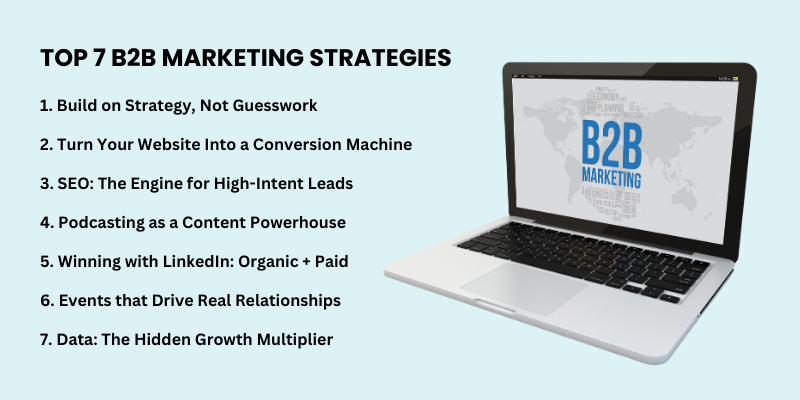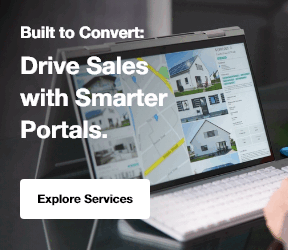When many firms think of B2B marketing strategies, their minds often go straight to direct and outbound tactics, messages delivered directly to clients or prospects with the goal of persuading them to take action and consider a service. While these techniques still hold value, the B2B marketing landscape has evolved dramatically. Buyer behavior has shifted, and today’s professionals are just as likely to search online for solutions to business challenges as they are to ask a trusted colleague for a recommendation. This shift has expanded the range of strategies available to marketers.
To remain competitive, firms must now embrace a broader mix of approaches that align with how modern buyers research, evaluate, and choose partners. But which strategies actually deliver results in today’s crowded marketplace? In this article, we’ll explore seven effective B2B marketing strategies and B2B marketing tactics designed to not only keep your firm relevant but also help you gain a competitive edge.
What is B2B Marketing?
B2B Marketing (Business-to-Business Marketing) refers to the strategies and practices that companies use to promote and sell their products or services to other businesses, rather than to individual consumers.

Unlike B2C (Business-to-Consumer) marketing, which focuses on appealing to personal desires and emotions, B2B marketing is centered around logic, value, and long-term relationships.
The goal is to show how a product or service can help another business increase efficiency, reduce costs, generate revenue, or gain a competitive advantage through Industrial Automation Solutions.
Key characteristics of B2B marketing include:
- Target Audience: Other businesses, organizations, or professional buyers (e.g., procurement teams, executives).
- Decision-Making Process: Often longer and more complex, involving multiple stakeholders.
- Messaging: Focuses on demonstrating ROI, solving pain points, and establishing trust and credibility.
- Channels: Includes content marketing, SEO, LinkedIn, trade shows, email campaigns, account-based marketing, and professional networking.
Top 7 B2B Marketing Strategies
Most conversations around B2B marketing strategies tend to highlight the latest trends or shiny new tactics. But what truly matters are the B2B strategies and marketing strategies for B2B that fuel real business growth.

Based on our experience working with clients and observing results across the B2B sector, we’ve identified the approaches that consistently drive measurable growth.
1. Build on Strategy, Not Guesswork
Our first and most important strategy is... strategy itself, particularly for Why Do Businesses Need B2B Web Development to optimize B2B operations. While it may sound obvious, many B2B firms, especially SMEs, skip over it, especially when they are unsure about what Is B2B Marketing Automation to integrate for optimized results. Instead of building a data-driven roadmap, they jump straight into tactics or channels, hoping for results. The reality: copying what you hear from other companies doesn’t guarantee success. Every market, audience, and buyer journey is different.
A strong strategy means stepping back and addressing:
- Who your buyers are, their pain points, needs, and decision-making process
- External factors shaping your industry
- Which channels does your audience actually use
- How competitors position themselves
- The resources and budget you have
- Which tools and technologies can support execution
- The KPIs that really matter to your growth
By grounding your B2B marketing strategy in real data instead of assumptions, you create a living roadmap that guides ongoing improvement and ensures every activity aligns with both buyer preferences and business goals.
This is especially true when understanding what is inbound marketing? a strategy rooted in attracting leads organically by delivering value at every stage of the buyer journey.
Explore Our B2B Marketing Services!
2. Turn Your Website Into a Conversion Machine
Your website isn’t just a digital brochure; it’s your most valuable sales asset. To truly optimize for conversions, consider using the Best eCommerce Platform for Small Business to enhance your site's performance. Many companies get started using the best website builders for small business to quickly establish an online presence, but to truly optimize for conversions, you need to go far beyond the basics.
Forget obsessing over button colors or tiny tweaks. In B2B, traffic is smaller than in B2C, so micro-changes rarely move the needle. Instead, focus on the big levers that transform results:
- Messaging & positioning – Communicate your value clearly and show how you’re different
- Page structure – Guide visitors logically toward action
- Social proof – Build trust with case studies, testimonials, and results
- Follow-up process – Ensure leads move seamlessly from form submission to sales conversation
Even a small improvement in CRO amplifies the impact of every demand generation activity, compounding growth across your entire marketing engine.
3. SEO: The Engine for High-Intent Leads
SEO remains one of the best B2B marketing strategies and strongest revenue drivers in B2B.
AI summaries may absorb some informational queries, but they can’t replace high-intent commercial searches.
When buyers search terms like “LinkedIn automation platform” or “buy LinkedIn automation software”, they’re ready to evaluate options. AI won’t make that decision for them.
Winning these searches requires more than optimized product pages. Search engines reward websites that demonstrate authority with depth of content. That means:
- Building clusters of educational content around your commercial terms with B2B content marketing services
- Publishing thought leadership
- Supporting product pages with informational articles
- Keeping commercial intent keywords at the heart of your SEO plan
Done right, SEO generates a pipeline from the buyers who are actively looking to purchase, and that’s traffic AI can’t steal.
Using tools like SEO ranking report software, marketers can measure keyword visibility and refine content strategies to stay competitive in search.
4. Podcasting as a Content Powerhouse
Launching a podcast rarely produces leads on its own. The real value comes from turning your episodes into a content engine.
Conversations recorded for a podcast are faster and more natural to create than blog posts or scripted videos.
In fact, many B2B marketing services firms use podcasts as a foundational content source to fuel their multi-channel strategies efficiently, turning the podcast into a content marketing solution b2b that powers multiple content forms.
- Short social media clips
- Full-length blog articles
- Video snippets across platforms
- Bite-sized videos for LinkedIn, TikTok, and more
Instead of chasing downloads, use podcasting as a scalable way to repurpose content and consistently feed your channels with authentic material that builds trust, awareness, and traffic.
5. Winning with LinkedIn: Organic + Paid
LinkedIn is unique in B2B: it reaches today’s buyers and the 95% of your market not actively looking yet.
Two approaches work best:
- Organic: Employee profiles drive far more engagement than company pages. Encourage team members to share insights, experiences, and thought leadership regularly. Keep the company page as a brand hub, but lean into people-driven visibility.
- Paid: LinkedIn’s ad targeting allows you to get in front of senior decision-makers long before they start evaluating vendors. This aligns with what is the digital marketing strategy that tracks users across the web? a reference to retargeting and behavioral tracking that enhances ad effectiveness across platforms.
Together, organic credibility and paid visibility make LinkedIn a powerful engine for brand and demand.
6. Events that Drive Real Relationships
Despite the digital shift, events remain a cornerstone of B2B relationship-building, especially in niche industries where online reach is limited.
The real ROI isn’t badge scans or immediate leads, but the meaningful conversations that turn into deals 6–12 months later. It’s worth noting that events often fall under what are five marketing strategies that retailers spend half of their annual budget on, underscoring their value across industries.
To maximize event impact:
- Focus on quality conversations, not sheer numbers
- Capture content (interviews, discussions, panels) to share later
- Use smaller meetups to dive deeper with your audience
- Track long-term pipeline contribution, not just short-term activity
Events also double as content goldmines, a B2B marketing best practice that allows you to extend the reach of your investment far beyond the venue.
7. Data: The Hidden Growth Multiplier
It may not feel like marketing, but data orchestration is the backbone of modern B2B growth.
Why? Because without pipeline visibility, you’re flying blind. Real performance data often reveals that:
- Certain lead sources close at 3x the rate of others
- Some channels generate higher deal values
- Sales cycles vary dramatically depending on the entry point
- High lead volume doesn’t always equal high lead quality
By connecting your systems and automating reporting, you gain clarity on what’s actually driving revenue. For example, tracking Google keyword ranking can help determine which search terms correlate with higher lead quality and better conversion rates. This insight allows you to:
- Prove ROI and justify higher budgets
- Focus resources on high-quality channels
- Align sales and marketing efforts around shared goals
Data orchestration isn’t a tactic; it’s an enabler. With it, every other strategy becomes sharper, more efficient, and more impactful.
7 Key B2B Marketing Strategies for 2025
This table highlights essential B2B marketing strategies and provides practical tools and real-world examples to help businesses optimize their marketing efforts. From account-based marketing (ABM) to leveraging AI and automation, these strategies offer actionable insights for achieving measurable growth and staying competitive in today’s digital landscape.
| Strategy | Key Insight | Practical Tools & Resources | Real-World Application |
|---|---|---|---|
| Build on Strategy, Not Guesswork | Emphasizes the importance of a data-driven marketing strategy tailored to specific business needs. | SWOT Analysis Template, Market Research Tools (e.g., Statista, IBISWorld), Competitor Analysis Framework | A SaaS company conducted a SWOT analysis and competitor benchmarking, leading to a refined value proposition that increased lead conversion by 30%. |
| Account-Based Marketing (ABM) | Focuses on personalized marketing efforts directed at high-value target accounts. | ABM Platforms (e.g., Demandbase, Engagio), CRM Integration Guides, Target Account Selection Criteria | A cybersecurity firm implemented ABM, resulting in a 40% increase in engagement from top-tier clients. |
| Content Marketing with Purpose | Advocates for creating valuable, relevant content that addresses the specific needs of the target audience. | Content Calendar Templates, SEO Tools (e.g., SEMrush, Ahrefs), Content Performance Metrics Dashboard | An enterprise software provider developed a series of industry-specific whitepapers, leading to a 50% rise in inbound inquiries. |
| Leverage Marketing Automation | Highlights the efficiency gains and personalized customer experiences achievable through automation. | Marketing Automation Platforms (e.g., HubSpot, Marketo), Email Campaign Templates, Lead Scoring Models | A manufacturing company automated its email nurturing campaigns, reducing manual effort by 60% and improving lead qualification accuracy. |
| Invest in Data-Driven Insights | Stresses the role of analytics in refining marketing strategies and measuring ROI. | Analytics Tools (e.g., Google Analytics, Tableau), Data Visualization Templates, KPI Tracking Dashboards | A financial services firm utilized data analytics to identify underperforming channels, reallocating budget to high-performing ones and increasing ROI by 25%. |
| Foster Customer Relationships | Encourages building long-term relationships through consistent engagement and support. | CRM Systems (e.g., Salesforce, Zoho CRM), Customer Feedback Tools, Loyalty Program Templates | A logistics company implemented a customer feedback loop, leading to a 15% improvement in customer satisfaction scores and a 10% increase in repeat business. |
| Embrace Emerging Technologies | Advocates for adopting new technologies like AI and machine learning to stay competitive. | AI Tools for Marketing (e.g., ChatGPT, Jasper), Machine Learning Resources, Innovation Adoption Framework | A retail analytics firm integrated AI-driven predictive analytics, enhancing forecasting accuracy and boosting sales by 20%. |
FAQs: B2B Marketing Strategies
What are the top B2B marketing strategies in 2025?
Top B2B marketing strategies in 2025 include building a data-driven roadmap, optimizing websites for conversions, leveraging SEO for high-intent leads, and using LinkedIn for both organic and paid engagement. These approaches ensure businesses stay relevant in a competitive market.
How can I improve my B2B marketing in 2025?
To improve B2B marketing, focus on personalized content, invest in SEO for high-conversion keywords, and use data tools to measure performance. These tactics will help enhance lead generation and boost ROI.
Why is SEO important for B2B marketing in 2025?
SEO is vital for attracting high-intent leads actively searching for business solutions. By focusing on valuable content and commercial intent keywords, businesses can improve their visibility and convert quality leads.
What is the role of LinkedIn in B2B marketing in 2025?
LinkedIn is a key tool for reaching decision-makers and engaging prospects. Combining employee-driven content with targeted paid ads can increase brand visibility and create valuable business connections.
How can podcasting boost B2B marketing in 2025?
Podcasting helps create authentic content that can be repurposed into blogs, social media, and videos. This increases engagement and builds trust, positioning businesses as industry authorities.
Conclusion: The Enduring Power of B2B Marketing
B2B marketing strategies are not merely about transactions; they're about cultivating enduring relationships built on trust, transparency, and mutual value. In an era where businesses are seeking partners who understand their unique challenges and goals, the significance of relationship marketing cannot be overstated. By focusing on long-term partnerships rather than short-term gains, companies like Centric can foster loyalty, encourage repeat business, and strengthen B2B lead generation through trust and value-based engagement — one of the most effective B2B marketing strategies highlighted in many B2B marketing articles and B2B marketing tips. This approach not only drives revenue but also positions a company as a trusted advisor in its industry. In essence, the true value of B2B marketing lies in its ability to forge connections that stand the test of time, ensuring sustained growth and success.








